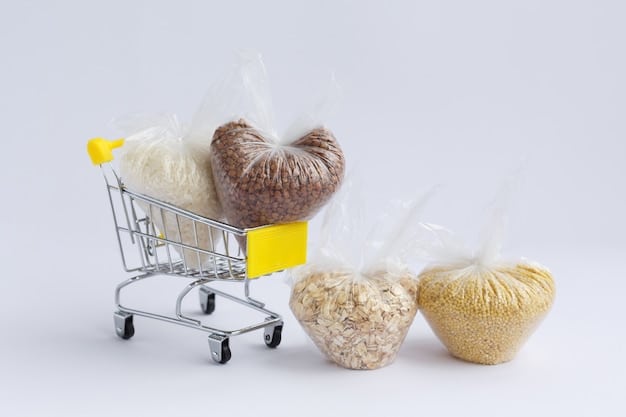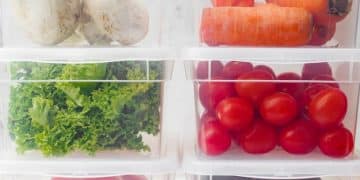Is Bulk Buying Cheaper? Grocery Savings Analysis 2025

Analyzing grocery purchasing habits for 2025 reveals that while bulk buying often presents cost-saving potential, its actual economic benefit hinges significantly on consumer behavior, storage capabilities, product shelf-life, and meticulous price-per-unit comparisons against smaller retail alternatives.
In the evolving landscape of household budgeting and grocery shopping, a perennial question arises: Is Buying in Bulk Really Cheaper? A Grocery Savings Analysis for 2025 aims to provide a comprehensive answer. This inquiry delves deep into consumer habits, market dynamics, and practical considerations, offering insights beyond simple price tags.
Understanding the Allure of Bulk Buying
The concept of buying in bulk has long been synonymous with savings. The fundamental premise is that purchasing larger quantities of goods leads to a lower price per unit. This strategy appeals to a wide range of consumers, from large families looking to stretch their budgets to individuals seeking to reduce the frequency of their shopping trips. However, the allure extends beyond mere financial incentives; it also encompasses convenience and perceived value.
Warehouse clubs and large supermarkets strategically market their bulk offerings, emphasizing the significant discounts available. Consumers are often drawn to the large, impressive packaging and the idea that they are getting more for their money. This psychological aspect plays a crucial role in the decision-making process, often overshadowing a detailed analysis of actual savings. The perception of a good deal can be a powerful motivator.
The Core Economic Principle
At its heart, bulk buying leverages economies of scale. Retailers can offer lower per-unit prices because their costs for handling, packaging, and transporting larger volumes are proportionately less. These savings are then ideally passed on to the consumer. For instance, a single 10-pound bag of rice might cost less per pound than ten 1-pound bags, simply because the packaging and distribution overhead for the larger bag are reduced.
- Reduced packaging waste: Fewer individual packages means less material used.
- Lower transportation costs: Moving larger quantities at once is more efficient.
- Streamlined warehouse operations: Less frequent restocking of inventory.
However, the economic principle only holds true if the consumer actually uses all the purchased goods before they spoil or become unusable. An unused portion negates any per-unit savings, transforming a potential gain into a net loss. This is where the practicalities of storage and consumption habits come into play, influencing the true cost-effectiveness of bulk purchases.
In conclusion, while the initial appeal of bulk buying is strong, rooted in the promise of significant savings and convenience, a deeper analysis reveals that its actual benefits are multifaceted. It requires more than just noting the discount; understanding the underlying economic principles and consumer responsibilities is key to truly leveraging its potential.
Factors Influencing Real Savings in 2025
While the initial price tag of bulk items often appears attractive, the true savings are determined by a complex interplay of various factors. As we look at 2025, these variables become even more critical due to shifting economic landscapes, supply chain dynamics, and evolving consumer habits.
One of the primary determinants is product perishability. Items with a short shelf life, such as fresh produce, dairy, or certain baked goods, are inherently risky bulk purchases. Even if the per-unit price is lower, spoilage negates any potential savings. Conversely, non-perishable goods like canned foods, dried pasta, rice, and household cleaning supplies are generally safer bets for bulk buying due to their extended shelf lives, allowing ample time for consumption.
Storage Capacity and Conditions
Adequate storage space is a often overlooked but critical factor. Bulk purchases, by their nature, occupy significant volume. Households with limited pantry space, small refrigerators, or no dedicated storage areas might find bulk buying more of a hindrance than a help. Furthermore, proper storage conditions are paramount to extending shelf life and preventing spoilage or infestation. Items like flour, sugar, or nuts can attract pests if not stored in airtight containers, which represents an additional investment.
- Dedicated pantry or closet space for dry goods.
- Adequate freezer capacity for bulk-purchased meats or frozen vegetables.
- Airtight containers to protect against moisture, air, and pests.
Another crucial element is the actual price per unit comparison. Shoppers must be diligent in calculating the per-unit cost (e.g., price per ounce, per pound, or per item) of bulk items versus smaller packages from various retailers. Sometimes, a “sale” on a smaller package at a standard grocery store can offer a better per-unit price than a bulk item at a warehouse club. This requires active engagement and comparison shopping, which many consumers simply do not do.

Finally, consumption rates play a significant role. Bulk buying makes sense only if the household consistently uses the product at a rate that allows for full consumption before expiration. A large family might quickly go through a bulk pack of toilet paper, but a single individual might find a bulk bag of fresh spinach spoils before it’s fully utilized. Impulse bulk purchases, without considering actual usage, often lead to waste rather than savings.
In summary, while the face value of bulk buys seems appealing, assessing the genuine financial benefit in 2025 necessitates a careful evaluation of the product’s lifespan, available storage, diligent price comparisons, and realistic consumption patterns. Overlooking any of these can turn a perceived saving into an actual loss.
Best and Worst Items to Buy in Bulk
The effectiveness of bulk buying largely depends on the specific types of products being considered. Not all items are created equal when it comes to the bulk purchase strategy. Distinguishing between items that yield genuine savings and those that lead to waste is crucial for any savvy shopper.
Generally, the “best” items for bulk purchase are non-perishable goods with long shelf lives and consistent usage. These include staples that every household consumes regularly, reducing the risk of spoilage or obsolescence. Think of items that won’t go bad and are always needed, allowing you to maximize the lower per-unit cost over time.
Top Performers for Bulk Buying
Certain categories consistently prove advantageous for bulk purchases due to their inherent characteristics. These are the items where the savings are most likely to materialize, assuming proper storage and consumption habits. Focusing on these can significantly impact a grocery budget without leading to excessive waste.
- Paper products: Toilet paper, paper towels, and tissues have indefinite shelf lives and are used daily. Their bulk packaging often offers substantial per-roll or per-sheet savings.
- Cleaning supplies: Laundry detergent, dish soap, all-purpose cleaners, and sponges do not expire quickly and are consumed steadily.
- Dried goods: Rice, pasta, beans, lentils, and oats are pantry staples with very long shelf lives when stored properly in airtight containers.
- Canned goods: Canned vegetables, fruits, and soups offer excellent longevity and are often cheaper in multipacks.
- Frozen foods: Provided ample freezer space, frozen fruits, vegetables, and certain meats can be bought in bulk and used over several months without spoilage.
- Bottled water and sodas: While not the healthiest, if consumed, bulk cases are invariably cheaper than individual bottles.
Conversely, some items are almost universally “worst” for bulk buying. These are typically goods with short shelf lives, items that lose quality quickly, or those that have highly variable consumption rates. Purchasing these in large quantities often results in financial waste due to spoilage or accumulation of unused product.
Items to Avoid Buying in Bulk
Understanding which products to steer clear of in bulk is as important as knowing what to buy. Avoiding these can prevent unnecessary expense and reduce food waste, contributing to a more efficient household budget. The quality and freshness factor often outweighs any per-unit price advantage.
- Fresh produce: Fruits and vegetables, unless destined for immediate consumption or freezing, spoil rapidly. Large quantities often lead to waste.
- Dairy products: Milk, yogurt, and cheese have limited shelf lives, making bulk buying risky unless consumed very quickly.
- Baked goods: Bread, pastries, and cakes go stale quickly, and while some can be frozen, quality often degrades.
- Spices and herbs: While they don’t exactly “spoil,” spices lose their potency and flavor over time. Bulk quantities typically mean they will be less flavorful by the time they are used up.
- Certain condiments: Ketchup, mustard, and mayonnaise have a shelf life once opened, and large containers might not be finished before expiration.
- Specialty items: Impulse buys of bulk specialty ingredients (e.g., obscure flours, exotic sauces) often gather dust in the pantry, unused.
In essence, strategic bulk buying involves a careful assessment of product characteristics, household needs, and storage capabilities. By focusing on non-perishable staples and avoiding highly perishable or seldom-used items, consumers can maximize savings and minimize waste in their grocery budget.
The Rise of Subscription Services vs. Traditional Bulk Stores
The landscape of bulk purchasing has evolved beyond the traditional warehouse club. In 2025, a significant contender in the savings arena is the rise of subscription services, offering a different approach to acquiring goods in larger quantities. Understanding the nuances between these two models is essential for optimizing grocery savings.
Traditional bulk stores, such as Costco or Sam’s Club, operate on a membership model. Consumers pay an annual fee to access these stores, which offer a wide array of products in large sizes. The appeal lies in the ability to physically inspect goods, the immediate gratification of bringing items home, and the breadth of product categories, from groceries to electronics.
Advantages of Traditional Bulk Stores
These stores offer a tangible shopping experience, allowing consumers to browse and discover new products. The vast aisles of large-quantity items create a sense of abundance and value. Furthermore, the membership model often includes additional perks like discounted gasoline, travel services, or optical centers, adding layers to the overall value proposition.
- Immediate access to purchased goods.
- Ability to physically examine products before buying.
- Often includes additional member benefits beyond just groceries.
- Wide variety of product categories in one location.
However, traditional bulk stores come with their own set of considerations. The membership fee, while potentially offset by savings, is an upfront cost. The physical act of shopping can be time-consuming, and navigating large quantities requires adequate personal transportation and onsite storage solutions. The sheer volume of some bulk items may also lead to over-purchasing or impulse buys that reduce overall savings.
The Emergence of Subscription Services
Subscription services, ranging from online bulk retailers like Boxed to specialized meal kit services or direct-to-consumer brands, provide an alternative. These services typically deliver goods directly to the consumer’s doorstep, often on a recurring schedule. Their appeal lies in convenience, curated selections, and the elimination of the need for in-person shopping.
- Convenience of home delivery, saving time and transportation costs.
- Automated reordering ensures consistent supply of frequently used items.
- Potentially less impulse buying compared to in-store shopping.
- Often a curated selection, reducing decision fatigue.
The main drawback of subscription services can be a potentially higher per-unit cost compared to traditional bulk stores, especially once shipping fees are factored in (unless a free shipping threshold is met). The inability to inspect goods before delivery is another consideration, and the selection might be narrower than what’s available in a large warehouse. Canceling or modifying subscriptions can sometimes be a hassle, leading to unwanted deliveries.

In conclusion, both traditional bulk stores and subscription services offer avenues for acquiring goods in larger quantities, each with distinct advantages and disadvantages. For 2025, the optimal strategy might involve a hybrid approach, leveraging the best of both worlds based on specific product needs and lifestyle preferences.
Impact of 2025 Economic Trends on Bulk Buying
The economic landscape of 2025 plays a significant role in shaping the viability and strategic importance of bulk buying. Inflation, supply chain stability, and consumer spending patterns directly influence product availability, pricing, and the overall value proposition of purchasing in larger quantities.
Inflation, which has been a prominent feature of recent years, directly impacts the cost of goods. When prices are rising, bulk buying can act as a hedge against future increases. Locking in a lower per-unit price for a significant quantity of non-perishable goods can shield consumers from subsequent price hikes, effectively saving money in the long run. This makes bulk purchases a more attractive option for stable, frequently used items.
Supply Chain Dynamics
The stability of global and local supply chains is another critical factor. Disruptions, whether due to geopolitical events, natural disasters, or labor shortages, can lead to product scarcity and price volatility. In such scenarios, consumers might consider bulk buying as a way to ensure they have essential goods on hand, reducing reliance on potentially unreliable supply lines.
- Increased consumer demand for non-perishable staples during uncertain times.
- Retailers may offer larger discounts on bulk to clear inventory or meet quotas.
- Potential for longer delivery times for online bulk orders.
Conversely, an overly stable or competitive market might see less aggressive bulk discounts, as retailers face less pressure to move large volumes quickly. The competitive landscape among grocery retailers in 2025, including discount chains and private labels, can also influence bulk pricing. Strong competition might drive down prices across the board, making the per-unit savings from bulk purchases less pronounced at times.
Consumer spending patterns are also influential. If discretionary income decreases, consumers might tighten their belts, making strategic bulk purchases of essentials a priority over smaller, more frequent buys. Conversely, if economic conditions improve, some consumers might reduce their bulk spending in favor of more convenient “as-needed” shopping, especially for items where storage is an issue.
Retailers, responding to these trends, might adjust their bulk offerings. We could see more flexible bulk options, smaller “bulk” packages, or innovative delivery methods to cater to evolving consumer needs and economic pressures. The emphasis might shift from sheer quantity to practical, manageable bulk solutions that align with shifting household budgets and storage realities.
In conclusion, 2025’s economic climate presents both opportunities and challenges for bulk buying. Consumers who remain informed about inflation trends, supply chain health, and market competition will be best positioned to leverage bulk purchases for maximum savings and household security, adapting their strategies as economic realities evolve.
Advanced Strategies for Maximizing Bulk Savings
Beyond the simple act of purchasing larger quantities, there are several advanced strategies that can significantly enhance the savings derived from bulk buying. These approaches require a more analytical and proactive mindset, transforming bulk shopping from a simple transaction into a sophisticated money-saving endeavor.
One key strategy is linking bulk purchases with sales cycles and coupons. Many warehouse clubs and supermarkets have predictable sales events. By tracking these cycles, consumers can time their bulk purchases to coincide with additional discounts, multiplying their savings. Combining these sales with manufacturer coupons, where applicable, can lead to substantial reductions in per-unit cost, sometimes even making items effectively free.
Cooperative Buying and Group Discounts
For individuals or smaller families who find the quantities in traditional bulk packages too extensive, forming a buying cooperative or splitting bulk purchases with friends, family, or neighbors can be highly effective. This allows multiple households to share the cost and quantity of a large item, benefiting from the bulk price without the individual burden of storage or risk of spoilage.
- Splitting large meat packs or produce boxes to avoid waste.
- Sharing subscription service orders to meet free shipping thresholds.
- सामूहिक negotiation for special bulk discounts from local suppliers.
Another advanced strategy involves meticulous inventory management. Knowing exactly what you have on hand, its expiration date, and its typical consumption rate prevents accidental duplicate purchases and ensures that bulk items are used within their optimal timeframe. Implementing a “first-in, first-out” (FIFO) system for pantry items is essential to achieve this, reducing waste and maximizing freshness.
Investing in appropriate storage solutions is also a critical, albeit often overlooked, aspect of advanced bulk saving. High-quality airtight containers, shelf organizers, and even an additional freezer can pay for themselves over time by preserving the quality and extending the life of bulk-purchased goods. This proactive investment prevents spoilage and maintains the integrity of food items, effectively safeguarding your initial financial outlay.
Finally, understanding the concept of “price floor” and “price ceiling” for frequently purchased items is invaluable. Establishing a mental benchmark of the lowest and highest acceptable per-unit prices for specific goods allows for highly informed purchasing decisions. Only buying when the price hits or falls below your “price floor” ensures you’re consistently getting the best possible deal, regardless of whether it’s a bulk or smaller purchase.
In conclusion, maximizing bulk savings in 2025 goes beyond simply buying big. It involves strategic timing, collaborative purchasing, rigorous inventory control, smart storage investments, and a deep understanding of pricing dynamics. Adopting these advanced strategies transforms bulk buying into a powerful tool for significant and sustained grocery savings.
Future Trends: Smart Technology and Personalized Bulk Buying
As we advance deeper into 2025, the future of bulk buying is poised for significant transformation, heavily influenced by smart technology and the growing demand for personalized solutions. These trends will likely redefine how consumers approach large-quantity purchases, making decisions more data-driven and tailored than ever before.
One major trend is the integration of AI and data analytics into consumer purchasing. Imagine apps that track your household’s consumption rates for various staples, predict when you’ll run out, and then suggest optimal bulk purchasing times based on real-time price comparisons across multiple retailers, including warehouse clubs and online subscription services. This level of personalized insight would virtually eliminate waste and maximize savings.
Smart Pantry and Inventory Systems
The concept of a “smart pantry” is moving from novelty to practicality. Devices equipped with sensors and cameras could automatically log items as they are added or removed, track expiration dates, and even suggest recipes based on available ingredients. This would revolutionize inventory management, making it easier for consumers to decide when and what to buy in bulk, preventing overstocking or spoilage.
- Automated reordering based on historical consumption data.
- Real-time alerts for expiring bulk items.
- Recipe suggestions tailored to bulk ingredients on hand.
Another emerging trend is the rise of highly customizable “mini-bulk” options. Recognizing that not every household has the space or consumption rate for traditional massive quantities, retailers may offer more flexible bulk sizing. This means smaller multi-packs or custom-packed quantities, allowing consumers to achieve some per-unit savings without the overwhelming commitment of gigantic sizes. This caters to a broader market, including single-person households or those with limited storage.
Blockchain technology could also play a role in enhancing transparency and trust in the bulk buying ecosystem. Consumers could potentially verify the origin, handling, and freshness dates of bulk products, especially in fresh produce or meat, providing greater assurance about the quality of their large-volume purchases. This added layer of information could build confidence and encourage more bulk buying in sensitive categories.
Finally, sustainability considerations will increasingly drive bulk buying decisions. As environmental awareness grows, consumers may prioritize bulk purchases that come with minimal packaging, are sourced locally, or contribute to less overall waste. Retailers could respond by offering more “zero-waste” bulk options, where consumers bring their own reusable containers, further aligning economic savings with eco-conscious practices.
In essence, the future of bulk buying in 2025 and beyond is not just about price, but about smart, precise, and environmentally conscious consumption. Technology will empower consumers with unprecedented data and customization, making bulk purchasing a more efficient, less wasteful, and highly personalized experience.
| Key Point | Brief Description |
|---|---|
| 💰 Savings Potential | Bulk buying can offer lower unit prices, but real savings depend on usage and spoilage. |
| ⚖️ Key Considerations | Evaluate product perishability, storage space, and actual household consumption rates. |
| 🛒 Best/Worst Buys | Non-perishables (paper goods, dried foods) are best; perishables (fresh produce, dairy) are worst. |
| 💡 Future Trends | AI, smart pantries, and personalized bulk options will enhance future savings strategies. |
Frequently Asked Questions About Bulk Buying
▼
Not always. The value of a warehouse club membership depends on your shopping habits and the extent of your savings. If your annual savings from bulk purchases significantly exceed the membership fee, it’s worthwhile. However, if you rarely shop there or can find similar or better deals elsewhere, the fee might negate any potential savings, making it less cost-effective.
▼
To accurately compare unit prices, always divide the total price by the total quantity (e.g., price per ounce, per pound, or per item). Many grocery stores provide unit pricing on shelf tags, which simplifies the comparison. If not, calculate it yourself to ensure you’re getting the true best deal, especially when comparing different brands or package sizes.
▼
Common pitfalls include purchasing perishable items that spoil, buying quantities larger than you can realistically consume, neglecting proper storage leading to waste, and impulse buying items just because they are in bulk. Failing to track consumption or not comparing unit prices across different retailers can also significantly diminish actual savings.
▼
It can do both. Bulk buying can promote a healthy diet by making it more cost-effective to purchase staples like whole grains, frozen fruits, and vegetables. However, it can hinder health if you overstock on unhealthy snack foods or processed items just because they are in bulk, leading to increased consumption and potential dietary imbalances.
▼
Bulk buying often reduces packaging waste, as larger containers typically use less material per unit of product than smaller individual packages. This can lower your environmental footprint. However, it’s important to consider personal consumption to avoid food waste, which also has a significant environmental impact. Reusable containers further enhance green bulk shopping.
Conclusion
As we conclude our analysis for 2025, it’s clear that the question, “Is buying in bulk really cheaper?” doesn’t have a simple yes or no answer. While the potential for significant savings is undeniable, realizing those benefits hinges on a multifaceted approach that considers product type, consumption habits, storage capabilities, and diligent price comparisons. The evolving retail landscape, marked by both traditional warehouse clubs and emerging subscription services, offers diverse avenues for bulk purchasing. Ultimately, an informed consumer, armed with strategic planning and an understanding of key economic trends, is best positioned to leverage bulk buying as a powerful tool for grocery savings and efficient household management.





